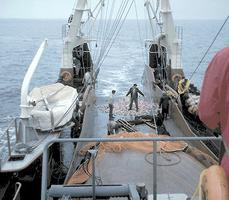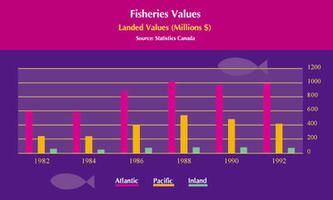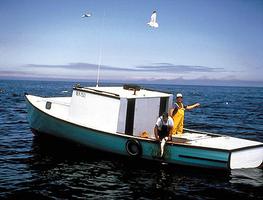Fisheries
The primary fishery output in Canada in 1995 is valued at $2.1 billion, 85% from the commercial fisheries and 15% from fish farming. With the value added in handling and processing, calculated at just under $2 billion, the total value of production for the industry in that year becomes $4 billion. The industry's role in the national economy is thus a minor one: even in the regional economy of the Pacific coast, its contribution to the output of all commodity-producing industries is only about 5%. On the Atlantic coast, however, the corresponding figure for Nova Scotia is 15% and for Newfoundland, 20%.Production is distributed among the Pacific (BC and Yukon, 20%), Central (Prairie Provinces and Ontario, 5%) and Atlantic (Québec, Maritime Provinces and Newfoundland, 75%) regions. Currently, Nova Scotia is the leading province (30% of total production), followed by BC and Nfld (each with about 20%). The industry exerts a powerful regional impact through links with suppliers of goods and services, especially shipbuilders but also ship chandlers and other intermediaries. These links, plus the interaction between fishermen's and plant-workers' households and the local community, ensure that the effect of economic change in the fisheries is transmitted and multiplied throughout the general economy.
Along the Atlantic coast, some 1000 communities have been wholly or mainly dependent on the fisheries. Lesser numbers of such communities also are found on the Pacific coast and around the lakes of the interior, often Native villages in the latter 2 regions. Most are hamlets of less than 500 people but the industry also supports larger urban centres in all 3 regions.
Employment in fishing and fish processing tends to be seasonal and much of it part-time. Half of the fishermen registered in the Atlantic region, two-thirds of those in the Pacific region and three-quarters of those in the Central region receive the larger part of their income from sources other than fishing. Some depend on fishing to augment other income, others participate because of cultural or family tradition and are often strongly attached to their identity as fishermen. Those who claim fishing as their principal source of livelihood typically derive about 65% of their total income from it. In the Pacific and Central regions, the balance comes mainly from non-fishing employment. In the Atlantic region the major income supplement is provided by unemployment insurance, to which self-employed fishermen (owner-operators) as well as crew have been entitled. Up to the present, the evidence suggests, most fishing enterprises have failed not only to generate surplus revenue, for capital accumulation and investment, but even to provide adequate personal income.
Resource Base
Fishery resources may be classified as finfish (including major marine species and all commonly used freshwater species) and shellfish (CRUSTACEANS and MOLLUSCS). Aquatic mammals and SEAWEEDS also are considered fishery resources. Marine species are classified as coastal or inshore (found within the 50-60 fathom contour adjacent to the coastline); demersal (dwelling near the sea floor, chiefly on offshore banks); and pelagic (occupying the surface of the open sea). Coastal stocks include crustaceans (LOBSTER and CRAB species) and molluscs (most CLAM species and OYSTERS).Demersal stocks include some crustaceans (crabs), a mollusc (SCALLOP) and a great variety of finfish (eg, COD and related species, FLATFISHES, rockfishes). The important pelagic species are all finfish (eg, HERRING, TUNA), except for one mollusc (the common SQUID). Certain species - eg, redfish (ocean perch), which combine demersal and pelagic features - elude this classification. Others, particularly the anadromous species that swim upstream to spawn (eg, SALMON), must be classified separately. Because of their dependence on watershed and estuarine habitats, anadromous species, along with the sedentary coastal species, are most vulnerable to environmental damage.
Demersal species and the larger or predator pelagic species are relatively long-lived and subject to low natural mortality. Demersal stocks tend to be quite stable, eg, the year-to-year variation in the Atlantic cod catch averages about 10%, compared with about a 30% variation in the PACIFIC SALMON catch. The smaller or forage pelagic species feed on PLANKTON and, being located at a low trophic level, generally occur in relative abundance. Because of high mortality in the younger stages, these stocks fluctuate widely, some (eg, common squid) in the short term and others (eg, some herring stocks) over the long term. A fish community as a whole has far greater stability than the many individual species stocks it contains.
Stocks of most pelagic species have a regular seasonal north-south migration pattern, sometimes over long distances. Some of these species, as well as anadromous and certain demersal species, also exhibit a seasonal inshore-offshore migration. The presence inshore of these stocks and of sedentary coastal stocks provides the basis for various small-boat fisheries. Operations on the offshore fishing grounds are based on schools (ie, feeding and spawning concentrations) of demersal and pelagic stocks and involve larger craft.
Canada has abundant fishery resources on the Atlantic and Pacific coasts and in inland waters but, while renewable, they are limited and exhaustible. Stock restoration and enhancement projections indicate that, even with full use of all available species stocks, the total yield or nominal catch is unlikely to exceed 2.5 million tonnes annually, ie, less than twice the 1985-95 average of 1.4 million tonnes. This amount would be not more than 2.5% of the annual world catch, which appears to have reached a limit at 100 million tonnes.
Resource Harvesting
A peculiarity of fishery resources is that typically they are common property, ie, under the "rule of capture," fish in a wild stock become the private property of a fishing enterprise only when caught and removed from the water. Each such enterprise therefore tries to maximize its share of a harvest limited by nature or regulation. The results are large fleets, high production costs, increased wastage and spoilage, and idle periods for vessels and handling/processing facilities. Moreover, because of mounting pressure to circumvent and subvert existing CONSERVATION measures, fish stocks are jeopardized.
This effect, possibly reinforced by environmental factors, is demonstrated in the Atlantic groundfish and Pacific salmon fisheries, the catches of which dropped by 85% and 55%, respectively, over the decade ending in 1995. These losses have been offset by a surge, during the same period, of 85% in the shellfish harvest and of 400% in farmed (chiefly salmon) output. As a result, combined with some increases in price, the overall port-market value of production rose by 60% in this period. It is significant that employment in the primary industry remained unchanged (at 85 000) by the end of this time and, although the fleet declined (by 12.5%) in number of fishing craft, it is doubtful that there was any reduction in fishing power. These trends prevailed consistently throughout the 3 regions.
Most Canadian fishing enterprises are individually owned and operated; partnerships are common in some fisheries and there are influential producers' co-operatives on both coasts and in the inland fisheries. Native bands run communal enterprises in certain areas. Vertical integration (ie, fleet ownership by corporations involved in fish processing) is predominant in the Atlantic trawling and scallop-dragging fisheries and, although declining in importance, still occurs in the Pacific purse-seining fishery and elsewhere.
Remuneration is generally made on the basis of shares in the proceeds of the catch. Typically the owner receives a fixed percentage as the "boat's" share and deductions are made to cover certain expenses and, in larger operations, officers' bonuses; the balance is then divided equally among the crew. Sharing ("lay") formulae vary with the scale of the operation; the owner's share in the Pacific purse-seining fleet is about 35%; in the Atlantic trawler fleet, 60%. With the unionization of crews, such arrangements are subject to bargaining and modification (for example, providing a basic rate of pay, regardless of the success of the trip).
A distinction is often made between small-scale and large-scale (ie, industrial) fishing enterprises, usually called "inshore" and "offshore," respectively. Inshore craft, defined for administrative purposes as those under 25 gross t, account for 95% of all vessels in the Canadian fleets but only 35% of the tonnage. The distinction, however, is an oversimplification: vessels of all sizes, except perhaps the smallest, sometimes fish the same grounds. More significant is the distinction between vessels with year-round versus seasonal operating capability and between those capable of versatile operation versus specialization.
Fish Processing
At least 95% of the Canadian fish harvest is converted to food products: 75% (25% chilled and 50% frozen) dressed and filleted forms, 15% cured and 5% canned. Advanced processing, ie, filleting/freezing, curing and canning, predominates, in response to the need for storage (because of seasonal peaking in raw-material supply), for transportation over long distances and for the provision of "convenience" foods.The industry consists of some 400 plants employing about 20 000 people: distributed roughly 75% in the Atlantic, 15% in the Pacific and 10% in the Central region. Apart from the Freshwater Fish Marketing Corp (a crown trading company), which handles about half the production of the Central region, fish processing is conducted exclusively in the private sector. Processing companies range from small, usually specialized firms to large, integrated ones supplying a wide variety of products.
In the Pacific region, consolidation of processing operations at major coastal centres has been accompanied by a massive concentration of ownership through mergers and acquisitions. Concentration has also taken place in the Atlantic region but there, until recently, it has not been associated with a consolidation of processing activity. In this region, as the traditional cottage industry declined in the post-WWII period, plant processing dispersed to replace it until, by the beginning of the present decade, close to 400 coastal communities were provided with processing facilities. Most of these were independently owned but many also belonged to (horizontally) integrated companies and co-operatives. Much of this capacity was grossly redundant and collapse of the cod fishery has forced some of it to be closed down, temporarily or permanently.
Marketing
Although a significant part of Canadian fish production is handled in the marketplace by specialized dealers, brokers and export/import houses, most is marketed by processing companies and co-operatives. Substantial quantities of some products, eg, canned salmon and frozen groundfish fillets, are prepared for export under the labels of foreign buyers.The Canadian fish trade has always been strongly export oriented and is likely to remain so. As of 1995, fishery-product exports were valued at $3 billion annually, thus accounting for three-fourths of total production in value terms. By product, these exports consist of shellfish (all forms, 50%), finfish (eg, those of freshwater origin), dressed/filleted, chilled/frozen (25%), cured and canned (10%) and other products (all forms, 15%). By destination, they were consigned to the US (50%), Japan (30%), the EU (10%) and all others (10%). The US is the major market for freshwater fish, chilled and frozen groundfish and shellfish products. Japan is the most important market for frozen salmon and the EU for canned salmon. Cured fish is exported to Caribbean and Mediterranean countries and canned herring is exported worldwide.
As indicated, the domestic market absorbs about one-quarter of total Canadian production. At $1 billion free on board the processing plant, this is likely to reach a value of $2 billion in the retail market. The proportion of the national output sold in Canada varies among products from virtually zero to 100%. Canned salmon probably is the major product for which the home market is the most important outlet. When domestic sources are deficient, supplemental supplies are imported. These are valued (1995) at $1.4 billion each year and consist of shellfish products (50%), chilled and frozen finfish products (25%) and all other products (25%). The US is the main source, at 45%, but supply is sourced from a wide range of other countries.
Per capita consumption of fish in Canada has approximated 7.5-8 kilos annually, consisting in the main of frozen fillet products (40%), shellfish products (uncanned, 20-25%), canned fish (other than shellfish) products (20%). This rate of consumption compares with a slightly lower rate in the US but is far less than that of many other countries.
Institutional Aspects
The 2 large fishermen's unions at present, in BC and Newfoundland, comprise fish-plant workers and some vessel owners as well as crew - groups with partially conflicting economic interests. Otherwise, fishermen on the Pacific coast, in inland waters and on the Atlantic coast outside Newfoundland are generally organized into associations based on a particular fishery, gear type or other special interest. In the Maritimes, many of these associations are linked by an umbrella federation. Unlike unions, which negotiate with buyers, mainly over fish prices, associations tend to represent members to government on matters of fishery regulation.
In addition, fishermen's co-operatives, which embrace processing and marketing as well as fish-harvesting operations, operate in BC, Saskatchewan, Québec and the Maritimes. Co-operatives and private firms in the processing and marketing divisions of commercial fisheries support associations representing the interests of those divisions. These associations, organized provincially, are federated in the Fisheries Council of Canada in Ottawa, the principal channel of communication between the fishing industry and the federal government.
The federal government has exclusive jurisdiction over fishing operations and over interprovincial and export trade in fishery products. The port market and fish handling and processing come under provincial jurisdiction. Subject to federal approval of regulations, management authority has been delegated to Ontario and to the Prairie provinces for commercial freshwater fisheries and to Québec for coastal marine fisheries.
All provincial governments and various federal agencies are active in fishery development activities; co-ordination of policy is sought, with mixed success, through a number of formal and ad hoc arrangements. The federal powers are exercised through the Department of Fisheries and Oceans and through certain special agencies which report directly to the minister of fisheries.
The national headquarters are in Ottawa; regional administrative headquarters are located in Vancouver, Winnipeg, Halifax, St John's and Moncton, NB. There are major research stations and laboratories at Nanaimo, BC; Winnipeg; Burlington, Ont; St Andrews, NB; Dartmouth, NS; and St John's (see also FISHERIES RESEARCH BOARD; FRESHWATER INSTITUTE).
The basic statute administered by the Department of Fisheries and Oceans is the Fisheries Act, under which regulations are made for fishery management, including the patrol of coastal waters, the protection of fish life in streams, etc. The Coastal Fisheries Protection Act empowers the government to control the conduct of foreign fishing vessels in Canadian ports and territorial waters, and the Fish Inspection Act provides for control of the quality of fishery products.
Assistance programs and intervention in industrial and trade development fall under a group of statutes, eg, the Fisheries Development Act and the Freshwater Fish Marketing Act.

 Share on Facebook
Share on Facebook Share on X
Share on X Share by Email
Share by Email Share on Google Classroom
Share on Google Classroom







